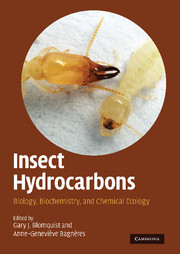Book contents
- Frontmatter
- Contents
- List of contributors
- Foreword
- Acknowledgments
- Part I Chemistry, Biochemistry, and Physiology
- Part II Chemical Communication
- 10 Perception and olfaction of cuticular compounds
- 11 Nestmate recognition in social insects and the role of hydrocarbons
- 12 Cuticular hydrocarbon cues in the formation and maintenance of insect social groups
- 13 Hydrocarbon profiles indicate fertility and dominance status in ant, bee, and wasp colonies
- 14 Chemical deception/mimicry using cuticular hydrocarbons
- 15 Behavioral and evolutionary roles of cuticular hydrocarbons in Diptera
- 16 Contact recognition pheromones in spiders and scorpions
- 17 Hydrocarbons as contact pheromones of longhorned beetles (Coleoptera: Cerambycidae)
- 18 Polyene hydrocarbons, epoxides, and related compounds as components of lepidopteran pheromone blends
- 19 Volatile hydrocarbon pheromones from beetles
- 20 Future directions in hydrocarbon research
- Index
19 - Volatile hydrocarbon pheromones from beetles
from Part II - Chemical Communication
Published online by Cambridge University Press: 18 May 2010
- Frontmatter
- Contents
- List of contributors
- Foreword
- Acknowledgments
- Part I Chemistry, Biochemistry, and Physiology
- Part II Chemical Communication
- 10 Perception and olfaction of cuticular compounds
- 11 Nestmate recognition in social insects and the role of hydrocarbons
- 12 Cuticular hydrocarbon cues in the formation and maintenance of insect social groups
- 13 Hydrocarbon profiles indicate fertility and dominance status in ant, bee, and wasp colonies
- 14 Chemical deception/mimicry using cuticular hydrocarbons
- 15 Behavioral and evolutionary roles of cuticular hydrocarbons in Diptera
- 16 Contact recognition pheromones in spiders and scorpions
- 17 Hydrocarbons as contact pheromones of longhorned beetles (Coleoptera: Cerambycidae)
- 18 Polyene hydrocarbons, epoxides, and related compounds as components of lepidopteran pheromone blends
- 19 Volatile hydrocarbon pheromones from beetles
- 20 Future directions in hydrocarbon research
- Index
Summary
The members of the Coleoptera, the largest insect order, are as diverse in their pheromone chemistry as they are in their appearance and biology. As in most other insect groups, long-range beetle pheromones tend to be oxygenated compounds, but some species use hydrocarbons. The hydrocarbon pheromones discussed here are distinguished from typical, cuticular hydrocarbons in that they are sex-specific, are small enough to be volatile (e.g., <25 carbons), and, in almost all cases, have been shown to elicit longrange behavioral responses. Most that have so far been encountered are male-produced and are attractive to both sexes, but there are exceptions. These hydrocarbons have proven to be chemically and biologically interesting, and some have become important in practical pest management. Biochemically, they include both polyketides and terpenoids. There is an extensive literature involving the hydrocarbon pheromones of sap beetles, and an effort is made here to give comprehensive coverage of this research. A smaller number of articles have been published about volatile hydrocarbon pheromones in other beetle families, and this information is covered in the latter portion of the chapter.
Sap beetles
Members of two sap beetle genera, Carpophilus and Colopterus (Coleoptera, Nitidulidae), have been found to use volatile hydrocarbons as long-range pheromones. These beetles are small in size (<5 mm) and cryptic in habits, but they are frequently abundant, feeding mostly on fruits or other plant materials that are ripening, decomposing, or fermenting. Several species are cosmopolitan and infest a variety of agricultural products, both before and after harvest.
- Type
- Chapter
- Information
- Insect HydrocarbonsBiology, Biochemistry, and Chemical Ecology, pp. 448 - 476Publisher: Cambridge University PressPrint publication year: 2010
- 5
- Cited by

